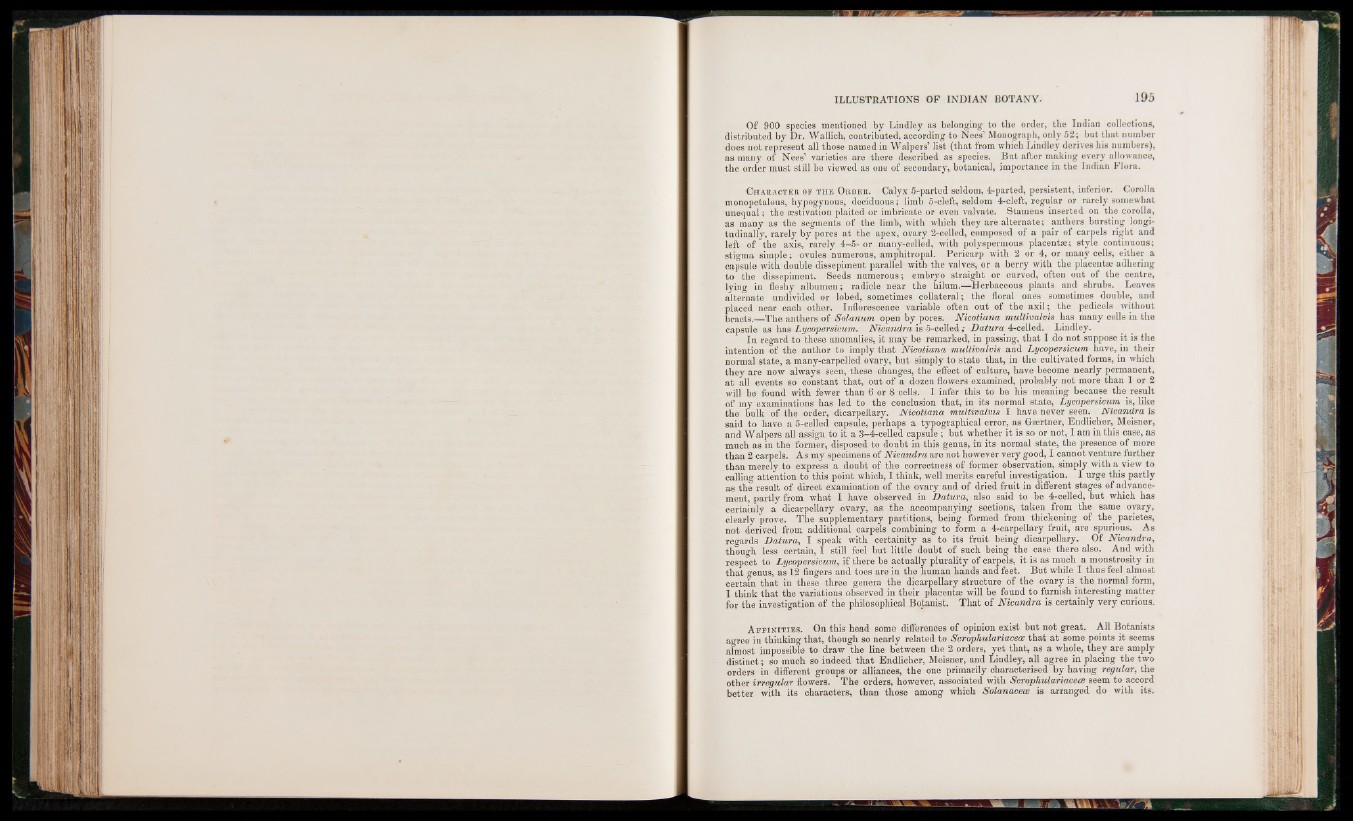
Of 900 species mentioned by Lindley as belonging to the order, the Indian collections,
distributed by Dr. Wallich, contributed, according to Nees1 Monograph, only 52; but that number
does not represent all those named in Walpers1 list (that from which Lindley derives his numbers),
as many of Nees1 varieties are there described as species. But after making every allowance,
the order must still be viewed as one of secondary, botanical, importance in the Indian Flora.
C h a r a c t e r of t h e O r d e r . Calyx 5-parted seldom, 4-parted, persistent, inferior. Corolla
monopetalous, hypogynous, deciduous; limb 5-cleft, seldom 4-cleft, regular or rarely somewhat
unequal; the aestivation plaited or imbricate or even valvate. Stamens inserted on the corolla,
as many as the segments of the limb, with which they are alternate; anthers bursting longitudinally,
rarely by pores at the apex, ovary 2-celled, composed of a pair of carpels right and
left of the axis, rarely 4-5- or many-celled, with polyspermous placentae; style continuous;
stigma simple; ovules numerous, amphitropal. Pericarp with 2 or 4, or many cells, either a
capsule with double dissepiment parallel with the valves, or a berry with the placentae adhering
to the dissepiment. Seeds numerous; embryo straight or curved, often out of the centre,
lying in fleshy albumen; radicle near the hilum.-—Herbaceous plants and shrubs. Leaves
alternate undivided or lobed, sometimes collateral; the floral ones sometimes double, and
placed near each other. Inflorescence variable often out of the axil; the pedicels without
bracts.—The anthers of Solarium open by pores. Nicotiana multivalvis has many cells in the
capsule as has Lycopersicum. Nicandra is 5-celled ,* Datura 4-celled. Lindley.
In regard to these anomalies, it may be remarked, in passing, that I do not suppose it is the
intention of the author to imply that Nicotiana multivalvis and Lycopersicum have, in their
normal state, a many-carpelled ovary, but simply to state that, in the cultivated forms, in which
they are now always seen, these changes, the effect of culture, have become nearly permanent,
at all events so constant that, out of a dozen flowers examined, probably not more than 1 or 2
will be found with fewer than 6 or 8 cells. I infer this to be his meaning because the result
of my examinations has led to the conclusion that, in its normal state, Lycopersicum. is, like
the bulk of the order, dicarpellary. Nicotiana multivalvis I have never seen. Nicandra is
said to have a 5-celled capsule, perhaps a typographical error, as Gasrtner, Endlicher, Meisner,
and Walpers all assign to it a 3-4-celled capsule; but whether it is so or not, I am in this case, as
much as in the former, disposed to doubt in this genus, in its normal state, the presence of more
than 2 carpels. As my specimens of Nicandra are not however very good, I cannot venture further
than merely to express a doubt of the correctness of former observation, simply with a view to
calling attention to this point which, I think, well merits careful investigation. I urge this partly
as the result of direct examination of the ovary and of dried fruit in different stages of advancement,
partly from what I have observed in Datura, also said to be 4-celled, but which has
certainly a dicarpellary ovary, as the accompanying sections, taken from the same ovary,
clearly prove. The supplementary partitions, being formed from thickening of the^ parietes,
not derived from additional carpels combining to form a 4-carpellary fruit, are spurious. As
regards Datura, I speak with certainity as to its fruit being dicarpellary. Of Nicandra,
though less certain, I still feel but little doubt of such being the case there also. And with
respect to Lycopersicum, if there be actually plurality of carpels, it is as much a monstrosity in
that genus, as 12 fingers and toes are in the human hands and feet. But while I thus feel almost
certain that in these three genera the dicarpellary structure of the ovary is^ the normal form,
I think that the variations observed in their placentae will be found to furnish interesting matter
for the investigation of the philosophical Botanist. That of Nicandra is certainly very curious.
A f f in i t i e s . On this head some differences of opinion exist but not great. All Botanists
agree in thinking that, though so nearly related to Scrophulariacece that a t some points it seems
almost impossible to draw the line between the 2 orders, yet that, as a whole, they are amply
distinct; so much so indeed that Endlicher, Meisner, and Lindley, all agree in placing the two
orders in different groups or alliances, the one primarily characterised by having regular, the
other irregular flowers. The orders, however, associated with Scrophulariacece seem to accord
better with its characters, than those among which Solanacece is arranged do with its.